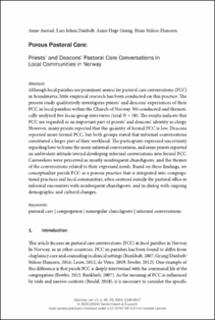| dc.contributor.author | Austad, Anne | |
| dc.contributor.author | Danbolt, Lars Johan | |
| dc.contributor.author | Grung, Anne Hege | |
| dc.contributor.author | Stifoss-Hanssen, Hans | |
| dc.date.accessioned | 2024-02-02T07:59:22Z | |
| dc.date.available | 2024-02-02T07:59:22Z | |
| dc.date.created | 2024-01-30T17:41:13Z | |
| dc.date.issued | 2023 | |
| dc.identifier.citation | Diaconia. Journal for the Study of Christian Social Practice. 2023, 14 (1), 35-60. | en_US |
| dc.identifier.issn | 1869-3261 | |
| dc.identifier.uri | https://hdl.handle.net/11250/3115172 | |
| dc.description | The journal shall appear twice a year. It is an open access publication licensed under a Creative Commons Attribution-Non-Commercial-No Derivatives 4.0 International License, accessible at DOI 10.13109/diac.2022.13.issue-1. For a copy of this license visit http://creativecommons.org/license/by-nc-nd/4.0/. | en_US |
| dc.description.abstract | Although local parishes are prominent arenas for pastoral care conversations (PCC) in Scandinavia, little empirical research has been conducted on this practice. The present study qualitatively investigates priests’ and deacons’ experiences of their PCC in local parishes within the Church of Norway. We conducted and thematically analyzed five focus-group interviews (total N = 58). The results indicate that PCC are regarded as an important part of priests’ and deacons’ identity as clergy. However, many priests reported that the quantity of formal PCC is low. Deacons reported more formal PCC, but both groups stated that informal conversations constituted a larger part of their workload. The participants expressed uncertainty regarding how to frame the many informal conversations, and some priests reported an ambivalent attitude toward developing informal conversations into formal PCC. Careseekers were perceived as mostly nonfrequent churchgoers, and the themes of the conversations related to their expressed needs. Based on these findings, we conceptualize parish PCC as a porous practice that is integrated into congregational practices and local communities, often centered outside the pastoral office in informal encounters with nonfrequent churchgoers, and in dialog with ongoing demographic and cultural changes. | en_US |
| dc.language.iso | eng | en_US |
| dc.publisher | Vandenhoeck & Ruprecht | en_US |
| dc.rights | Attribution-NonCommercial-NoDerivatives 4.0 Internasjonal | * |
| dc.rights.uri | http://creativecommons.org/licenses/by-nc-nd/4.0/deed.no | * |
| dc.subject | pastoral care | en_US |
| dc.subject | congregation | en_US |
| dc.subject | nonregular church goers | en_US |
| dc.subject | informal conversations | en_US |
| dc.title | Porous pastoral care. Priests' and deacons' pastoral care conversations in local communities in Norway | en_US |
| dc.type | Peer reviewed | en_US |
| dc.type | Journal article | en_US |
| dc.description.version | publishedVersion | en_US |
| dc.rights.holder | © 2024 Vandenhoeck & Ruprecht, Robert-Bosch-Breite 10, D-37079 Göttingen, ein Imprint der Brill-Gruppe | en_US |
| dc.source.pagenumber | 35-60 | en_US |
| dc.source.volume | 14 | en_US |
| dc.source.journal | Diaconia. Journal for the Study of Christian Social Practice | en_US |
| dc.source.issue | 1 | en_US |
| dc.identifier.doi | 10.13109/diac.2023.14.1.35 | |
| dc.identifier.cristin | 2238805 | |
| cristin.ispublished | true | |
| cristin.fulltext | original | |
| cristin.qualitycode | 1 | |

